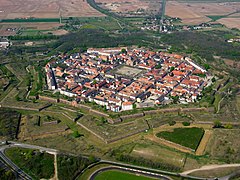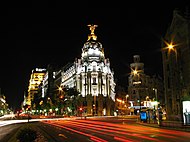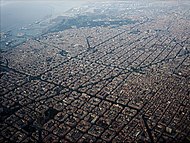Cityscape
Cityscape is mostly a cultural-geographic term that is also often used in everyday language. It describes the effect and subjective perception of an urban space through the entirety of its cultural and natural components. Thus, the cityscape primarily means the visual perception of a city in its entirety.
features
Components of a cityscape are usually buildings , squares and wide streets as well as green areas , but also striking mountains , rocks or rivers , which together form urban landscapes. In contrast to the skyline , the viewing angle on the cityscape is not specified. The cityscape is therefore also a totality of all perspectives. Conceptually, a distinction is made between the graphically displayed city view (cf. Vedute , Weichbild ).
The cityscape is a feature of the regional identification of cities and regions and creates a recognition value in addition to individual landmarks . With these characteristics, it is also used for city marketing . Examples of mottos or slogans that also take up the cityscape are Stuttgart ( city between forest and vines ), Güstrow (the future has tradition here ), Krefeld ( city like velvet and silk ) or Schwerin ( royal city with a fairytale castle ).
Debates
Controversies often develop over the preservation, redesign or recovery of a traditional cityscape, such as debates about the reconstruction of the Frauenkirche and the surrounding Neumarkt in Dresden , the Dom-Römer project in Frankfurt am Main or the reconstruction of buildings around the Old Market in Potsdam . Critics attest the reconstructed streets lacking authenticity and ingratiation. In Germany, urban monument protection has established itself to protect and harmoniously develop the historic city centers . The Stadtbild Deutschland association is committed to the reconstruction of historical buildings and annually selects a “Building of the Year”, in 2016 the rebuilt Barberini Palace in Potsdam.
Which cityscapes are worth preserving is subject to historical change and controversial among contemporaries. This shows the change in historical awareness and raises the question of social identity. In addition to historic cities also now apply fortified towns like Neubreisach , planned cities like La Chaux-de-Fonds or after the Second World War , rebuilt on old floor plan Freudenstadt , completely rebuilt inner cities of the post-war period as Chemnitz or founding cities of the GDR as Eisenhüttenstadt as worthy of preservation.
- Cityscapes of all kinds
Founding city of the GDR: Eisenhüttenstadt
(photo 1956)
New urbanism
The new urbanism is an overarching theme in the development of today's cityscapes. The character of the cities should be changed by developments in the modern age of architecture, influenced by the Athens Charter and the idea of the “ car-friendly city ”. The fragmentation and mixed use that once prevailed in most cities has been abandoned by many urban planners, architects and politicians, and areas that are used separately for residential and commercial purposes, loosened settlements and increasingly satellite towns have emerged . This development was already criticized by contemporaries of the early modernist movements, for example by supporters of homeland security architecture and especially from the 1970s with the emergence of the monument protection movement .
Since the 1980s, with the urbanism movement, block perimeter development and mixed use of districts have been preferred. According to this, this type of urban development should support the increased urban life through social and economic mixing and a saving of resources (e.g. travel routes, land and energy consumption) compared to the loosened settlements. New urbanism aims to maintain and develop sustainable cityscapes. Architectural sustainability also mostly plays a role, for example through the use of natural and local materials and forms of expression .
Endangering the cityscape
During the Second World War, great damage occurred, which often impaired the cityscape of many cities to a large extent (see table of bombed cities ). In Germany around 53 cities were more than 50% destroyed, 45 of them in the west and 8 in the east. In the post-war decades , the cityscape in Germany was impaired by the demolition of historical buildings in favor of new buildings, as well as by opening wide streets for a car-friendly city . In West Germany , there were interventions in the historical building fabric through measures such as removal of stucco and the removal of old windows and shutters made of wood and replacement with industrial building materials and products. In street furniture such as street lamps, more emphasis was often placed on functionality.
A rethink followed from the 1970s. Old building fabric was increasingly preserved or exposed again. The urban development programs in West Germany have renovated and upgraded many of the mostly older city centers and districts from the early days in need of renovation.
From the end of the 1970s onwards, the facades of buildings were changed through subsequent thermal insulation measures , often to the detriment of the cityscape.
Fall of the Iron Curtain
From the 1990s onwards, as a result of the collapse of communism, there were naturally major cuts, also in the cityscapes of the countries concerned, and great opportunities opened up that had long been wasted in the West.
East Germany
As a result of the shortage economy, many historic city centers and Wilhelminian-style districts in East Germany were spared total renovations in the West, but increasingly fell into disrepair. At a distance from neglected inner cities, new residential quarters were built in an industrial style ( prefabricated building ). In the 1980s, a rethink began in the GDR and historic buildings began to be restored , as in Görlitz . In other cities the intention was to demolish older city quarters ( Schwerin - Schelfstadt ) or old quarters were so neglected in terms of the building fabric that demolition was almost inevitable or that they were rebuilt in the "socialist understanding of building" ( Halberstadt ).
Since the turn of 1990/91, the East German cities have experienced a careful and sustainable renewal on a very large scale. The federal / state program for urban monument protection , introduced in Germany for the first time, was initially intended to bring about unity between urban and building renovation and monument protection in significant, historic city centers in 162 cities in the new federal states , whereby the preservation and improvement of the cityscape was important.
- “But why did the renewal and revitalization of the historic urban areas in the new federal states become a recognized model of success? First of all, the documentaries in almost all cities [...] clearly illustrate the positive changes with a direct comparison of images of the state of the inner cities around 1990 and today: the photos from the time of the fall mainly show urban ensembles characterized by structural decay and renovation jams physical existence appear seriously endangered. In this "GDR biotope" an incomparable architectural treasure of original historical substance had survived, which in the old states had long been sacrificed for the reconstruction in the economic boom or the clear-cutting restoration. "
Today, many large and small East German cities again have an almost intact cityscape, as a total work of art through all historical epochs, from the medieval city center, possibly the palace or castle , through the Wilhelminian- style districts to villas on the outskirts. For example in Erfurt , Potsdam , Schwerin , Naumburg , Pirna , Quedlinburg , Greiz , Meiningen or Putbus .
In addition, the outskirts are generally less built up than in the west. In the east, for example, historical structures often border directly on nature or lakes or historical landscape parks , with a merging or harmonious transition from the cityscape to the landscape (e.g. Potsdam, Schwerin, Blankenburg , Putbus).
- Naumburg: Example of a completely preserved East German cityscape including infrastructure
Austria
The northern Mühlviertel and Waldviertel , close to the Iron Curtain , naturally stood in the shadow of economic development in the post-war decades. Here, too, the cityscapes developed similarly to those in East Germany, for example in Freistadt or Weitra .
Eastern Europe
In the countries of the former Eastern Bloc there was also a similar development as in East Germany, but in a weaker form due to lower funds. In the states of the former Danube monarchy in particular, the particularly rich historical heritage and the value for tourism were recognized in many places, such as in Karlsbad or in the Croatian seaside resort of Opatija , the former St. Jakobi.
Other countries
Switzerland
In Switzerland, there have been three developments since the post-war period, more clearly than in many other places in the West, also benefiting from the intactness of the cityscape during the war. Closed, historical cityscapes have been completely preserved, without the usual interventions of the post-war decades elsewhere, such as the Zähringer cities of Bern or Freiburg im Üchtland .
In other cities there was a coexistence between modern and old, without blurring or adaptation, as in Basel . Again in others, even small towns, modern city centers have been built in a metropolitan style in a confined space, including the like. a. built with high-rise buildings, such as in Biel , Olten , Siders or La Chaux-de-Fonds.
Northern Europe
As a result of adapting to the climate, building heights in Northern Europe are usually significantly lower. In addition, exposed brickwork with clinker bricks is often characteristic of the cityscape in northwestern Europe, due to the milder winter .
Southern and Western Europe
In southern Europe there are generally much higher, shady buildings, sometimes in connection with the narrowest streets, such as in Lucca, Italy .
Even smaller cities often have boulevards with very high, enclosed buildings, such as Cuneo in northern Italy . In Grenoble , one boulevard even surpasses Parisian standards, the Cours Jean Jaurès .
The modern cityscape also often ties in with the old one. Like La Défense near Paris, with the Grande Arche , on the Avenue des Champs-Élysées and the Arc de Triomphe . In contrast, the Highlight Tower in Munich , for example, protrudes uncoordinated over Ludwigstrasse and Siegestor .
Influence of the Roman Empire

Southern Europe is also strongly influenced by the urban heritage of the Roman Empire .
“The Roman Empire has had a lasting impact on our culture to this day, u. a. through the Roman language, Roman law, but also Roman town planning. "
A planned city was laid out in Turin in the Baroque period , with boulevards and squares that served as a model for other cities, among others. a. Nice .
Even in modern post-war urban planning , old, dead straight Roman roads were integrated in an urban way. In contrast to Germany, where this cultural heritage has been neglected, as on the route from the Main to the Taunus , through Frankfurt-Höchst and Bad Soden .
Modern large housing estates were also, i. Ggs. To Germany, often laid out in a representative way. With large boulevards that open up the district and often also serve as the main access to the city center. Often with two symmetrically arranged residential high-rise buildings as "entrance gate". For example Croix d'Argent in Montpellier .
Old and New World
Conventional European standards were broken in Spain in the 19th century . Cities emerged with huge dimensions and structures, such as the Eixample in Barcelona .
They can also be found in the areas of South America conquered by Spain . For example in Buenos Aires , where the Avenida 9 de Julio, planned in 1888 and only begun in the 1930s, breaks all previous standards.
See also
Web links
Individual evidence
- ↑ Andreas Voigt: The Germans' longing for the old days. In: Welt Online , March 21, 2011; Against architectural populism. In: Baunetz , May 7, 2018.
- ↑ Katharina Wiechers: Palais Barberini in Potsdam is "Building of the Year". In: Der Tagesspiegel , January 10, 2016.
- ^ Katja Marek: Reconstruction and cultural society. Cityscape repair in Dresden, Frankfurt am Main and Berlin as an expression of the contemporary search for identity. Dissertation, Kunsthochschule Kassel 2009, p. 172 f. (PDF) .
- ↑ Charter of New Urbanism - German translation of the Engl. Charter of the New Urbanism
- ↑ In the damming mania: building renovation changes the cityscape. In: 3sat.de , April 9, 2015; Niklas Maak : The burqa for the house. In: Frankfurter Allgemeine Zeitung , November 16, 2010.
- ↑ a b c Gerd Dietrich: Kulturgeschichte der DDR, Göttingen 2018. Retrieved on September 22, 2018 .
- ↑ Andreas Ranft & Stephan Selzer: Cities from Trümmern, Göttingen 2004. Accessed on September 24, 2018 .
- ↑ SpringerLink: Why urban renewal became a model for success in East Germany ... Accessed on September 21, 2018 .
- ↑ Oliver Neumann: Review of "The Roman City" by Paul Zanker. Retrieved September 25, 2018 .
- ↑ Vera Comoli: Turin. The invention of a baroque capital of absolutism, in: Planstädte der Neuzeit . Publication accompanying the exhibition at the Badisches Landesmuseum Karlsruhe, 1990, pp. 133–142.


















